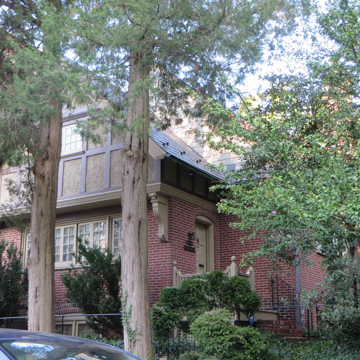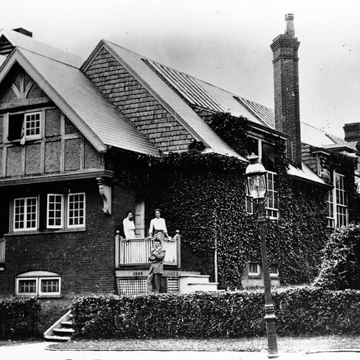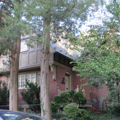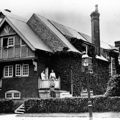The quaint complex tucked into a narrow lot amid hollies and hemlocks is a rare, unaltered survival of nineteenth-century artists' studios still used for their original purpose. The famous illustrator Pyle returned to his native Wilmington from New York in 1879 and built the first studio (at rear) in this growing district. The cottagelike Queen Anne–style building stood eighty feet back from the street, where the lot widened. Inside were brick fireplaces; heavy, curved ceiling beams; skylights; and rustic-looking walls of unpainted shingles (white today). The Old-English flavor befitted the Anglophilia of Pyle, illustrator of the King Arthur and His Knights series of books (1903–1910). A shingled section of the house to the west has a doorway and marble steps that appear to be recycled from a town house of c. 1800, typical of Pyle's acquisition of historical fragments.
Pyle taught summer sessions at Chadds Ford, Pennsylvania, and, in 1900, built three attached studios along the southwest edge of the lot for “the boys” of the Howard Pyle School of Art. That institution trained N. C. Wyeth (who arrived in fall 1902), Frank Schoonover (see WL86), and other painters of the Brandywine group. Like Pyle's studio itself, the school buildings epitomize the Queen Anne style, with complex massing, jutting half-timbered gables, and tall chimneys. Big windows and skylights admitted the coveted north light. In Pyle's day, the complex was open and sunny, its brick-work cloaked in ivy. Repointing has obscured the original mortar joints, thin and dark. Millstones and a datestone (1799) dot the pavement outside. Pyle died in Italy in 1911, and pupil Stanley Arthurs owned the studio from 1920 to 1950. The Studio Group of local painters has preserved the property since 1964.














